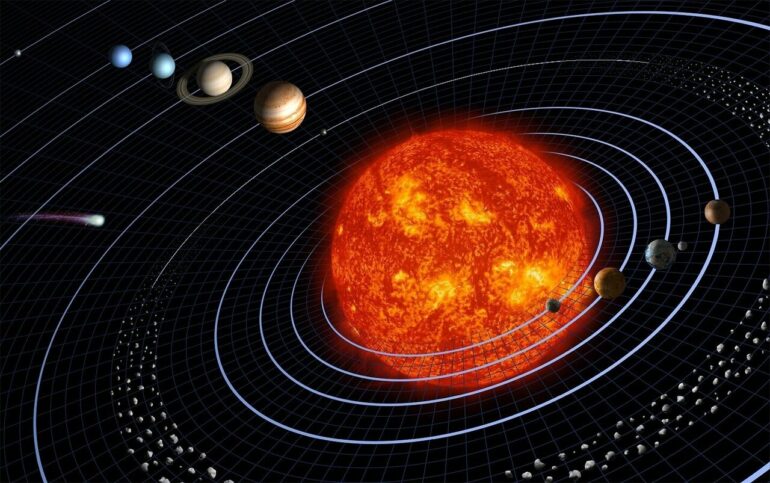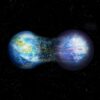The primitive asteroids that UCF physics doctoral student Brittany Harvison studies carry with them traces of their origins and billions of years of our solar system’s history.
Harvison pored through a library of infrared telescope data to analyze the spectral composition of 25 members of the Erigone family of primitive asteroids and help fill in the gaps in our understanding of the creation of our solar system.
The data on the Erigone asteroids, which are located in the main asteroid belt found between the orbits of Mars and Jupiter, was collected as part of the PRIMitive Asteroid Spectroscopic Survey (PRIMASS) project co-led by UCF planetary scientist Noemí Pinilla-Alonso.
Harvison’s work, which was published in the journal Icarus, lays the foundation for future research, and may get scientists closer to concluding if asteroids brought water to Earth and if so, how much.
“There are theories that the Earth could have received a fraction of its water from primitive asteroids in the early solar system,” says Harvison, who is also a researcher at the Florida Space Institute (FSI). “A big portion of these theories is understanding how these primitive asteroids were transported into Earth’s path. So, exploring primitive asteroids in the solar system today could help paint a picture of what was going on all those years ago.”
Some of these cosmic travelers, including the asteroids within the Erigone family, have hydrated silicates. The existing hydrated bodies that continue to move throughout our solar system could tell us more about those that collided with Earth.
It is one of the many outstanding questions that Harvison’s work is hoping to address.
“We mainly wanted to see if there were primitive asteroid families similar to the Erigone and Polana asteroid families,” Harvison says. “We used spectroscopy to study what kinds of minerals were on the surface to understand their composition.”
From the study, Harvison and her co-authors saw that the Erigone and Polana families are different from one another in the near infrared but that the other primitive families have their own levels of red color in their spectral distribution along with their own unique levels of hydration.
In other words, the primitive families in the inner solar system show a variety of redness and hydration. The analysis and comparison show evidence that these families are not linked to the proposed Erigone-like or Polana-like groups, challenging the previously held theories as to where they fit in. Also, one particular asteroid, (52246) Donaldjohanson, seems to belong to the Erigone family based on its spectrum.
Piecing together history
Due to the importance of understanding the nature of primitive objects, numerous spacecraft have targeted primitive asteroids, such as JAXA’s Hayabusa2 and NASA’s OSIRIS-REx, which visited, studied, and returned samples from Ryugu and Bennu, respectively.
Bennu and Ryugu prompted researchers to further study primitive asteroids and figure out where they came from, Harvison says.
Erigone was one of the final pieces of the large library of PRIMASS data that existed, but had yet to be studied, Harvison says. PRIMASS aims to understand the diversity of surface properties among primitive collisional families in the asteroid belt and map their composition.
A collisional family of asteroids refers to a group of asteroids that are believed to have originated from the breakup of a larger parent body due to a collision. The members of a collisional family provide information about the interior of the intact body they were part of before the impact.
The PRIMASS project is characterizing the collisional families of primitive asteroids in the main belt, and particularly those that could be the origin of the primitive near-Earth asteroids such as Bennu and Ryugu.
The conclusions drawn by studying collisional families like Erigone are critical puzzle pieces in the greater endeavor of understanding the creation of our solar system.
“The larger scope was to look at primitive families in the inner part of the main asteroid belt, where Ryugu and Bennu are thought to have likely originated,” she says. “The Erigone family was the last piece of the puzzle to be placed into the PRIMASS library to provide full context on primitive asteroids in this region and allow other scientists to analyze the data.”
Harvison’s research provides supplemental context for the upcoming NASA Lucy mission, which will have the eponymous spacecraft visiting (52246) Donaldjohanson in Spring 2025 before it moves on to examine eight Trojan objects (space rocks trapped in Jupiter’s orbit) in 2027 through 2033.
Looking to the future
Study co-author Mário De Prá, an assistant scientist at FSI, served as a research assistant and Harvison’s co-supervisor. Co-author Pinilla-Alonso is Harvison’s research advisor and assisted Harvison in her research.
Pinilla-Alonso says she’s delighted to assist Harvison and see her growth.
“For me, it was a pleasure to see the process and the end result,” she says. “She contacted me early during the pandemic when we were all working at home to express her interest in pursuing a Ph.D. degree here at UCF. Here we are about three years later: she has done an awesome job and there is more to come.”
Pinilla-Alonso and Harvison say they were surprised that no one had studied the spectroscopy of the Erigone family.
“When Brittany landed on this project, we saw there was one piece of information we were missing,” Pinilla-Alonso says.
“PRIMASS had completed the analysis of the visible and near-infrared of all the primitive families in the inner belt but there was one missing family: Erigone. That was very important because it was the family that could give closure to learning about the inner [asteroid] belt families. Until you ask the right question or have the tools, sometimes you don’t seek that answer. But, in this case, we had the observations done and it was clear that we needed to analyze it.”
The knowledge gained from studying Bennu, Ryugu, and the Erigone and Polana primitive asteroid families will serve as a springboard for future James Webb Space Telescope observations and NASA missions.
“It is very exciting times going through all of this new data with more to come with the James Webb Space Telescope,” Pinilla-Alonso says. “I really think the biggest discovery is yet to come. The data we can collect from Earth is limited. Now, we have the best tool in space to keep learning more.”
Pinilla-Alonso, Harvison and other researchers at FSI are slated to begin using the JWST as early as this summer to observe Erigone and other primitive asteroids, and, over a span of about two years, evaluate the collected spectra.
Harvison maintains her enthusiasm as she looks forward to building upon her analyses and further unraveling the origins of these primitive asteroids.
“There’s this fascination when I’m looking at this data and I’m examining something that’s millions of miles away,” Harvison says. “We can look back billions of years and learn the initial structure and composition of the early solar system by studying the surface of these asteroids. That’s always been something that excites me.”
More information:
Brittany Harvison et al, PRIMASS near-infrared study of the Erigone collisional family, Icarus (2024). DOI: 10.1016/j.icarus.2024.115973
Provided by
University of Central Florida
Citation:
Student’s comparative analysis of primitive asteroids provides context for further research, future NASA missions (2024, May 13)



